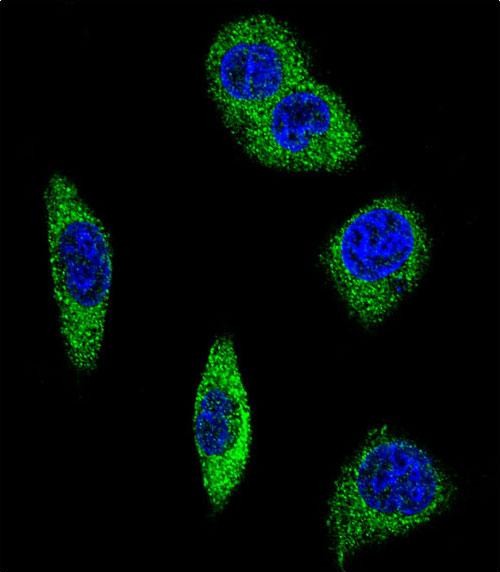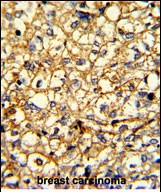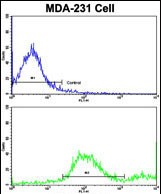ADRA2B Antibody (Center)
Affinity Purified Rabbit Polyclonal Antibody (Pab)
- SPECIFICATION
- CITATIONS
- PROTOCOLS
- BACKGROUND

Application
| WB, IF, FC, IHC-P, E |
|---|---|
| Primary Accession | P18089 |
| Reactivity | Human |
| Host | Rabbit |
| Clonality | Polyclonal |
| Isotype | Rabbit IgG |
| Calculated MW | 49954 Da |
| Antigen Region | 343-369 aa |
| Gene ID | 151 |
|---|---|
| Other Names | Alpha-2B adrenergic receptor, Alpha-2 adrenergic receptor subtype C2, Alpha-2B adrenoreceptor, Alpha-2B adrenoceptor, Alpha-2BAR, ADRA2B, ADRA2L1, ADRA2RL1 |
| Target/Specificity | This ADRA2B antibody is generated from rabbits immunized with a KLH conjugated synthetic peptide between 343-369 amino acids from the Central region of human ADRA2B. |
| Dilution | WB~~1:1000 IF~~1:10~50 FC~~1:10~50 IHC-P~~1:50~100 E~~Use at an assay dependent concentration. |
| Format | Purified polyclonal antibody supplied in PBS with 0.09% (W/V) sodium azide. This antibody is purified through a protein A column, followed by peptide affinity purification. |
| Storage | Maintain refrigerated at 2-8°C for up to 2 weeks. For long term storage store at -20°C in small aliquots to prevent freeze-thaw cycles. |
| Precautions | ADRA2B Antibody (Center) is for research use only and not for use in diagnostic or therapeutic procedures. |
| Name | ADRA2B |
|---|---|
| Synonyms | ADRA2L1, ADRA2RL1 |
| Function | Alpha-2 adrenergic receptors mediate the catecholamine- induced inhibition of adenylate cyclase through the action of G proteins. The rank order of potency for agonists of this receptor is clonidine > norepinephrine > epinephrine = oxymetazoline > dopamine > p-tyramine = phenylephrine > serotonin > p-synephrine / p-octopamine. For antagonists, the rank order is yohimbine > chlorpromazine > phentolamine > mianserine > spiperone > prazosin > alprenolol > propanolol > pindolol. |
| Cellular Location | Cell membrane; Multi-pass membrane protein. Note=Interaction with RAB26, GGA1, GGA2 and GGA3 mediates transport from the Golgi to the cell membrane. |

Thousands of laboratories across the world have published research that depended on the performance of antibodies from Abcepta to advance their research. Check out links to articles that cite our products in major peer-reviewed journals, organized by research category.
info@abcepta.com, and receive a free "I Love Antibodies" mug.
Provided below are standard protocols that you may find useful for product applications.
Background
Alpha-2-adrenergic receptors are members of the G protein-coupled receptor superfamily. They include 3 highly homologous subtypes: alpha2A, alpha2B, and alpha2C. These receptors have a critical role in regulating neurotransmitter release from sympathetic nerves and from adrenergic neurons in the central nervous system. Alpha 2B adrenergic receptor subtype was observed to associate with eIF-2B, a guanine nucleotide exchange protein that functions in regulation of translation. A polymorphic variant of the alpha2B subtype, which lacks 3 glutamic acids from a glutamic acid repeat element, was identified to have decreased G protein-coupled receptor kinase-mediated phosphorylation and desensitization; this polymorphic form is also associated with reduced basal metabolic rate in obese subjects and may therefore contribute to the pathogenesis of obesity. Alpha 2B adrenergic receptor gene contains no introns in either its coding or untranslated sequences.
References
Tabakoff,B., et.al., BMC Biol. 7, 70 (2009) Weinshank,R.L., et.al. Mol. Pharmacol. 38 (5), 681-688 (1990)
If you have used an Abcepta product and would like to share how it has performed, please click on the "Submit Review" button and provide the requested information. Our staff will examine and post your review and contact you if needed.
If you have any additional inquiries please email technical services at tech@abcepta.com.













 Foundational characteristics of cancer include proliferation, angiogenesis, migration, evasion of apoptosis, and cellular immortality. Find key markers for these cellular processes and antibodies to detect them.
Foundational characteristics of cancer include proliferation, angiogenesis, migration, evasion of apoptosis, and cellular immortality. Find key markers for these cellular processes and antibodies to detect them. The SUMOplot™ Analysis Program predicts and scores sumoylation sites in your protein. SUMOylation is a post-translational modification involved in various cellular processes, such as nuclear-cytosolic transport, transcriptional regulation, apoptosis, protein stability, response to stress, and progression through the cell cycle.
The SUMOplot™ Analysis Program predicts and scores sumoylation sites in your protein. SUMOylation is a post-translational modification involved in various cellular processes, such as nuclear-cytosolic transport, transcriptional regulation, apoptosis, protein stability, response to stress, and progression through the cell cycle. The Autophagy Receptor Motif Plotter predicts and scores autophagy receptor binding sites in your protein. Identifying proteins connected to this pathway is critical to understanding the role of autophagy in physiological as well as pathological processes such as development, differentiation, neurodegenerative diseases, stress, infection, and cancer.
The Autophagy Receptor Motif Plotter predicts and scores autophagy receptor binding sites in your protein. Identifying proteins connected to this pathway is critical to understanding the role of autophagy in physiological as well as pathological processes such as development, differentiation, neurodegenerative diseases, stress, infection, and cancer.





